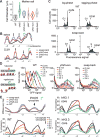Resetting the Yeast Epigenome with Human Nucleosomes
- PMID: 29198523
- PMCID: PMC5732057
- DOI: 10.1016/j.cell.2017.10.043
Resetting the Yeast Epigenome with Human Nucleosomes
Abstract
Humans and yeast are separated by a billion years of evolution, yet their conserved histones retain central roles in gene regulation. Here, we "reset" yeast to use core human nucleosomes in lieu of their own (a rare event taking 20 days), which initially only worked with variant H3.1. The cells adapt by acquiring suppressor mutations in cell-division genes or by acquiring certain aneuploid states. Converting five histone residues to their yeast counterparts restored robust growth. We reveal that humanized nucleosomes are positioned according to endogenous yeast DNA sequence and chromatin-remodeling network, as judged by a yeast-like nucleosome repeat length. However, human nucleosomes have higher DNA occupancy, globally reduce RNA content, and slow adaptation to new conditions by delaying chromatin remodeling. These humanized yeasts (including H3.3) pose fundamental new questions about how chromatin is linked to many cell processes and provide a platform to study histone variants via yeast epigenome reprogramming.
Keywords: chromatin; genomics; histone; histones; humanized; synthetic biology; systems biology.
Copyright © 2017 Elsevier Inc. All rights reserved.
Figures







Similar articles
-
Biochemical assay for histone H2A.Z replacement by the yeast SWR1 chromatin remodeling complex.Methods Enzymol. 2012;512:275-91. doi: 10.1016/B978-0-12-391940-3.00012-3. Methods Enzymol. 2012. PMID: 22910211
-
Purification of yeast histones competent for nucleosome assembly in vitro.Yeast. 1994 Mar;10(3):319-31. doi: 10.1002/yea.320100305. Yeast. 1994. PMID: 8017102
-
Histone chaperone spt16 promotes redeposition of the original h3-h4 histones evicted by elongating RNA polymerase.Mol Cell. 2009 Aug 14;35(3):377-83. doi: 10.1016/j.molcel.2009.07.001. Mol Cell. 2009. PMID: 19683500
-
Chromatin-remodeling and the initiation of transcription.Q Rev Biophys. 2015 Nov;48(4):465-70. doi: 10.1017/S0033583515000116. Q Rev Biophys. 2015. PMID: 26537406 Review.
-
Transcription through nucleosomes.Biophys Chem. 2000 Aug 30;86(2-3):231-7. doi: 10.1016/s0301-4622(00)00134-4. Biophys Chem. 2000. PMID: 11026687 Review.
Cited by
-
Developmentally programmed histone H3 expression regulates cellular plasticity at the parental-to-early embryo transition.Sci Adv. 2023 Apr 7;9(14):eadh0411. doi: 10.1126/sciadv.adh0411. Epub 2023 Apr 7. Sci Adv. 2023. PMID: 37027463 Free PMC article.
-
Genetic Engineering and Synthetic Genomics in Yeast to Understand Life and Boost Biotechnology.Bioengineering (Basel). 2020 Oct 29;7(4):137. doi: 10.3390/bioengineering7040137. Bioengineering (Basel). 2020. PMID: 33138080 Free PMC article. Review.
-
Rapid, scalable, combinatorial genome engineering by marker-less enrichment and recombination of genetically engineered loci in yeast.Cell Rep Methods. 2023 May 10;3(5):100464. doi: 10.1016/j.crmeth.2023.100464. eCollection 2023 May 22. Cell Rep Methods. 2023. PMID: 37323580 Free PMC article.
-
Scalable, Continuous Evolution of Genes at Mutation Rates above Genomic Error Thresholds.Cell. 2018 Dec 13;175(7):1946-1957.e13. doi: 10.1016/j.cell.2018.10.021. Epub 2018 Nov 8. Cell. 2018. PMID: 30415839 Free PMC article.
-
Mechanisms of gene regulation by histone degradation in adaptation of yeast: an overview of recent advances.Arch Microbiol. 2022 Apr 28;204(5):287. doi: 10.1007/s00203-022-02897-8. Arch Microbiol. 2022. PMID: 35482104 Review.
References
-
- Acker J, Conesa C, Lefebvre O. Yeast RNA polymerase III transcription factors and effectors. Biochim Biophys Acta. 2013;1829:283–295. - PubMed
-
- Ahmad K, Henikoff S. The histone variant H3.3 marks active chromatin by replication-independent nucleosome assembly. Mol Cell. 2002;9:1191–1200. - PubMed
-
- Annunziato AT. Split decision: what happens to nucleosomes during DNA replication? J Biol Chem. 2005;280:12065–12068. - PubMed
-
- Bernstein E, Hake SB. The nucleosome: a little variation goes a long way. Biochem Cell Biol. 2006;84:505–517. - PubMed
-
- Boeke JD, Trueheart J, Natsoulis G, Fink GR. 5-Fluoroorotic acid as a selective agent in yeast molecular genetics. Methods Enzymol. 1987;154:164–175. - PubMed
MeSH terms
Substances
Grants and funding
LinkOut - more resources
Full Text Sources
Other Literature Sources
Molecular Biology Databases

